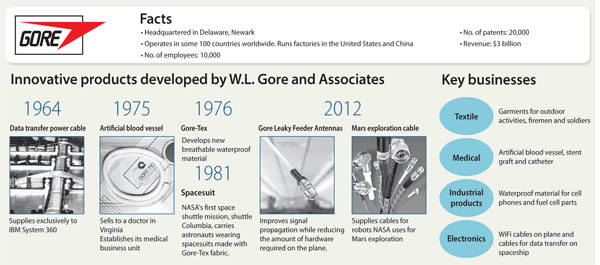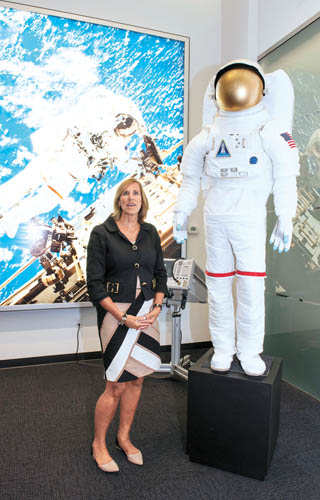Gore-Tex maker plans to grow in a ‘complex’ future


Terri Kelly, CEO of Gore&Associates, poses with a space suit made by the company in 1981. [Gore&associates]
In an interview with the JoongAng Ilbo at the W. L. Gore and Associates offices on Sept. 9, Kelly picked several key words for future generations of materials designers, such as space and medicine.
She said she believes the materials industry will help human beings travel freely to places with extreme conditions, such as space, the deep sea, remote deserts or the North Pole.
After beginning at the company in 1983 as a mechanical engineer, Kelly became CEO in 2005. She granted a rare interview to the JoongAng Ilbo to discuss core issues in the industry for the next 50 years. The following are excerpts from that conversation.
Q. Common words in today’s business community are complexity and future. What are the key or critical issues for you looking at the next 50 years?
A. Have you heard the term “VUCA?” It refers to “Volatile, Uncertain, Complex, Ambiguous.” I think a key issue is how we prepare our future leaders to navigate through a VUCA world.
A critical issue every company is facing is just how quickly things are moving. It is about the uncertainty and the complexity, how digital technology has really transformed and how businesses operate.
I think it is important how we make sure we understand how those trends right in front of us will change our business model, or even the products that we sell.
I’d ask, if I look 50 years out, “How do we prepare the leaders of the future to lead in a very different operating environment?” I think probably one of the biggest challenges is getting leaders comfortable with a lot of uncertainty, a lot of ambiguity, a lot of complexity.
Which sector are you interested in for the future?
Medicine.
You mean you will enter the pharmaceutical business?
We will not make drugs. But there are many challenges in the future in terms of how you store pharmaceutical drugs, how you deliver and process them, and then even how you supply them to a patient.
As an example, pharmaceutical processing has lots of challenges. Some of the processes have to be done at what’s called “cryogenic temperatures,” which means very cold. So the area creates significant challenges for storage and materials. Our materials can go down to extreme cold, so that’s a perfect opportunity, because we can provide flexibility in storage.
Do you think the competitiveness that W. L. Gore and Associates has today will stay the same in the future?
I think if we just stayed frozen today, we would absolutely lose our competitive differentiation. I have confidence in our associates, because they like to push the boundaries in terms of our materials.
A great example is if you look at the whole change in oil and gas exploration and some of the “fracking technology” [in which water is injected into rock to extract oil or gas] in the United States, there are some very interesting challenges. Workers have to do deep-hole drilling while also protecting their electronics.
This is a new market we would never have envisioned maybe seven, eight years ago, but it has now presented some interesting opportunities in protective clothing for those working in the environments, as well as protective materials for the equipment that needs to function.
Is there any key change or trend in materials science?
The big trend is moving from just a monolithic, single material to multiple materials that can be combined together. This whole trend is how our materials can be a great carrier for coatings or other chemical components that can change properties.
One of the broader trends I mentioned is the incorporation of drugs into the devices.
One of the promising trends is trying to increase the performance of a stent graft [a tube used to reinforce the weak spots in arteries, commonly referred to as aneurisms] by including various drugs in a way in which they’re locally delivered exactly where they’re needed to be to improve the aneurism.
You are also running an “incubator,” or a team whose research is long-term and may not lead to any big breakthroughs in the foreseeable future. What exactly are they doing?
I think it is important that how you position a team so that they have the ability to focus on things that are longer term. Looking at the medical industry in particular, it typically takes seven to 10 years to bring a product to market, so you have to be very patient.
How can you forecast future trends?
We give a lot of autonomy to our business units to think about what is the right approach. So even though we look at our materials as kind of an enterprise resource, each of our business units are very much looking at what’s happening in the market and how we connect with where we can add value.
What messages do you want to deliver to Korean readers?
“The future is uncertain. Let’s prepare tomorrow’s leaders to be agile.” I think our approach is that yes, the leaders play an important role to create the context, but we want our associates to be aware and be part of solving some of these issues, and I think that helps them grow as associates.
BY LEE HYUN-TAEK [kim.heejin@joongang.co.kr]










with the Korea JoongAng Daily
To write comments, please log in to one of the accounts.
Standards Board Policy (0/250자)